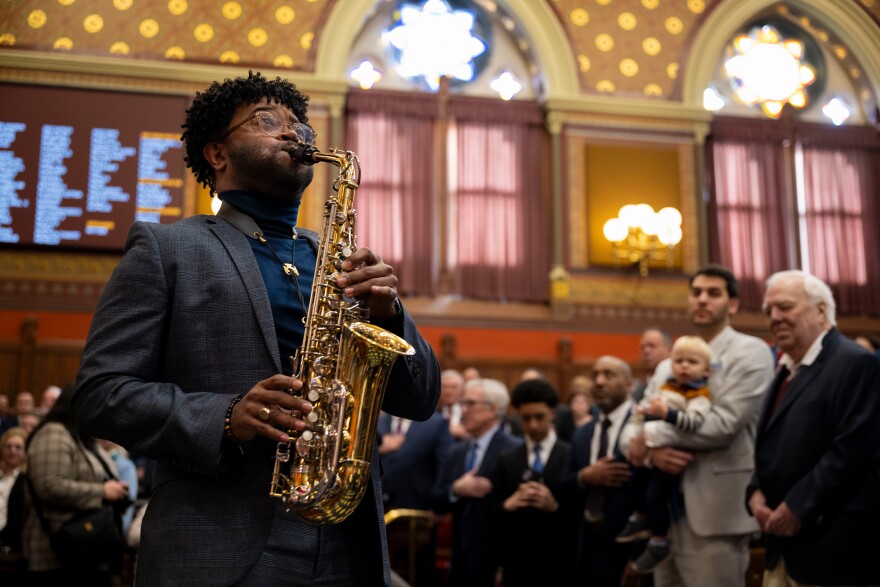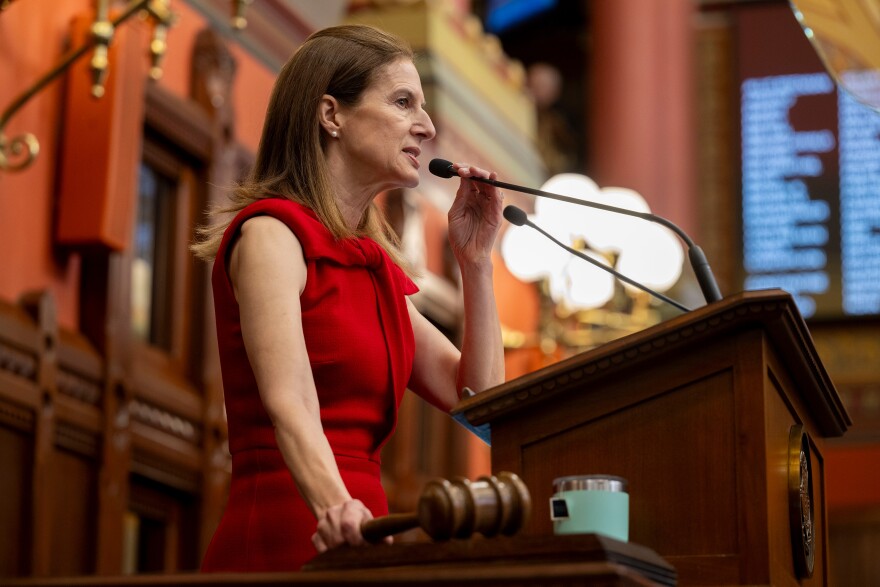Less than two weeks before President-elect Donald Trump is set to take office, Connecticut’s General Assembly reconvened for its 2025 legislative session.
For nearly five months, the part-time legislature will discuss bills, hear public testimony and vote on legislation in committee and on the House and Senate floor. Lawmakers will also decide on the state’s next two-year budget.
The session began Wednesday with Connecticut Gov. Ned Lamont’s State of the State address at the Capitol in Hartford.
The two-term Democratic governor will present lawmakers with a budget proposal in the coming weeks.
"And always, our north stars will be affordability and opportunity, holding down costs of energy and education, allowing you to keep more of what you earn and providing you the tools you need to earn more, to buy a home, start a business," Lamont said during his address.
Lawmakers must end the regular session business by midnight on June 4.
High cost of power dominates early parts of Lamont's speech
Affordability and the high cost of electricity in Connecticut dominated the early parts of Lamont's speech to lawmakers, with the governor saying expensive power impacts everyone from families to small business owners.
"They’re asking me about the reliability and affordability of electricity, as everything we do gets more energy intensive," Lamont said.
Lamont said the state needs to increase its supply of low-carbon energy, but Connecticut continues to rely on two major staples for its electircal supply: natural gas and nuclear energy, the latter of which accounts for about one-third of in-state electricity.
Nuclear energy raises concern among environmentalists
Lamont hinted during his speech Wednesday that nuclear power could grow in Connecticut.
"Nuclear power that provides most of our carbon-free power," he said. "Right now, we're working with the federal government to find ways to expand nuclear capacity in Connecticut."
But environmental groups immediately voiced that the state needs to focus more on renewable energy options, not more nuclear power.
"Offshore wind is, was and will continue to be a huge part of getting us to our emissions goals that both the Governor and the legislature and the public have adopted," Lori Brown, executive director of the Connecticut League of Conservation Voters, said at the Capitol. "And we cannot afford to slide back from that."
Last month, the state officially opted out of buying into a new offshore wind project with Massachusetts and Rhode Island. Lamont told Connecticut Public's "The Wheelhouse" in December that the project ended from concern over cost to ratepayers.
Charles Rothenberger, a climate and energy attorney at Save the Sound, also expressed concern about the state depending more on more nuclear energy.
"I don't believe it is a cheaper alternative to actual clean renewable energy," Rothenberger said, citing offshore wind and solar as alternatives. "And those are projects that could come online much more quickly to help serve our needs, improving the resilience of the grid and lowering costs for customers."
State lawmakers decry federal 'chaos'
Democrats hold an overwhelming majority in both houses of the General Assembly.
During remarks Wednesday, Democratic House Speaker Matt Ritter urged legislators to work in a bipartisan fashion, in contrast to what he said happens in Washington D.C., as well as in many other state governments.
"People get elected and they have new majorities," Ritter said. "There's a new majority in D.C.; there's a new majority here ... and the first thing that they plan to do is find ways to eliminate all of the opposition's power."
Everyone is frustrated by federal lawmakers who risk chaos, said Vincent Candelora, Connecticut House Republican Minority Leader. He said he watched the recent election of U.S. House Speaker Mike Johnson when the election of the speaker was in question.
"It struck me that either party would stand and allow potentially an institution to be put into chaos and jeopardy for political gain," Candelora said. "And I think time and again we see that on the federal level."

A 'cheeky' touch of CT showmanship
Name-checking Connecticut showman P.T. Barnum during his address, Lamont acknowledged a touch of hyperbole in the state’s recent rollout of road signs declaring Connecticut the “pizza” and “basketball” capital of the world.
Lamont said those signs attracted a lot of attention.
"Some people thought the signs were a little cheeky. Italy questioned our claim to be the pizza capital. The Boston Celtics wondered about the basketball capital," Lamont joked. "But as a great showman, and Connecticut state representative, P.T. Barnum famously said, ‘I don’t care what they say about me, as long as they spell my name right.’ And they’re talking about Connecticut."
Lamont says he wants to continue efforts to raise the state’s profile.
Over the holidays, Connecticut leaned into its role as a Hallmark movie backdrop, launching a Christmas Movie Trail to highlight spots from movies filmed in the state.
This session is fundamentally different from last year’s
This session is a “long” one, as outlined by the state’s Constitution. In odd-numbered years, the governor’s office and state lawmakers must agree on a new two-year budget.
That means this year, Lamont must present his proposed state budget and bond package to lawmakers by Feb. 5. That sets off a month-long process to negotiate and finalize, which in the end requires a simple majority in both chambers, where Democrats hold a majority, along with the governor’s signature for approval.
The 2025 session will be nearly two months longer than the “short” session in even-numbered years, when lawmakers usually adjust the budget. Last year, things turned out a little differently when Lamont and other Democratic lawmakers assigned expiring American Rescue Plan Act (ARPA) dollars to help programs, rather than formally adjusting the budget.
Expect some debate on state’s fiscal guardrails
These constraints, first enacted in 2017, are a complex set of rules for how much lawmakers can spend. Connecticut has been able to pay down pension debt and has seen state budget surpluses under the guardrails, but there has also been considerable debate among some lawmakers about the need to change these policies. Advocates and lawmakers who want to see the guardrails loosened say they want to see more state money for health care, child care and education.
Lamont said he wanted to keep the guardrails during a December appearance on Connecticut Public’s “The Wheelhouse.” Some Republicans have also echoed a desire to keep the guardrails in place.
Top leaders are the same
Democrats still hold a comfortable majority in both state legislative chambers.
Ritter will return to lead the chamber alongside Majority Leader Jason Rojas. Candelora will return as House Minority Leader. Martin Looney and Bob Duff return as Senate Pro Tem and Majority Leader, respectively. And State Sen. Stephen Harding will return for his second year as Republican Minority Leader.

Bills, bills, bills
Over half a dozen of the nearly 30 committees have new House leaders. Legislative committees drive policy debate among lawmakers and engage the public on specific issues like education, health care and the environment. This year, there is a new committee on government oversight and a select committee on special education.
While many bills are proposed each year by lawmakers, comparatively few become law. That’s because there is a specific process for how most bills become a law, which the Connecticut General Assembly learning center explains. (Think: ”Schoolhouse Rock’s” “I’m Just a Bill” sans music).
There are also a number of different types of bills. Some come out of committees or are introduced by individual lawmakers or groups of lawmakers, or the governor. Among the many topics that will likely come up this session:
- Addressing the housing crisis, such as passing “Work, Live, Ride,” which would have created incentives for municipalities to increase housing near transportation hubs, but died in the 2024 legislative session.
- Crafting rules to make absentee ballots available for all Connecticut voters. Voters approved so-called “no excuse” absentee balloting in a November 2024 ballot referendum.
- Re-examining the number of required early voting days in Connecticut. Last year was the state’s first foray into early voting. Turnout was high during the general election in November, but there were concerns about early voting during the primaries earlier in the year. Some town officials cited low turnout and long, state-mandated staffing hours.
- Reducing greenhouse gas emissions in the state, and building resiliency to the climate crisis. The issue of energy and the economy has been on the mind of many voters and the governor, who recently pulled out of a multi-state deal to procure offshore wind.
- Discussing enhancements to the state’s aging electrical grid, and high utility rates.
- Tackling medical costs, from a task force on high prescription prices to potentially expanding “HUSKY for immigrants” eligibility for people ages 16-18.
Ways to get involved
Committees will hold public hearings, where people can make their voices heard in a few ways. That can be through written testimony on the CGA website – or speaking at the public hearing, Public hearings are also often broadcast online.
There’s also a bill tracking system – that’s not just for reporters and stakeholders! Anyone can sign up to see how a bill is progressing.
Connecticut Public's Matt Dwyer and Patrick Skahill contributed to this report.












